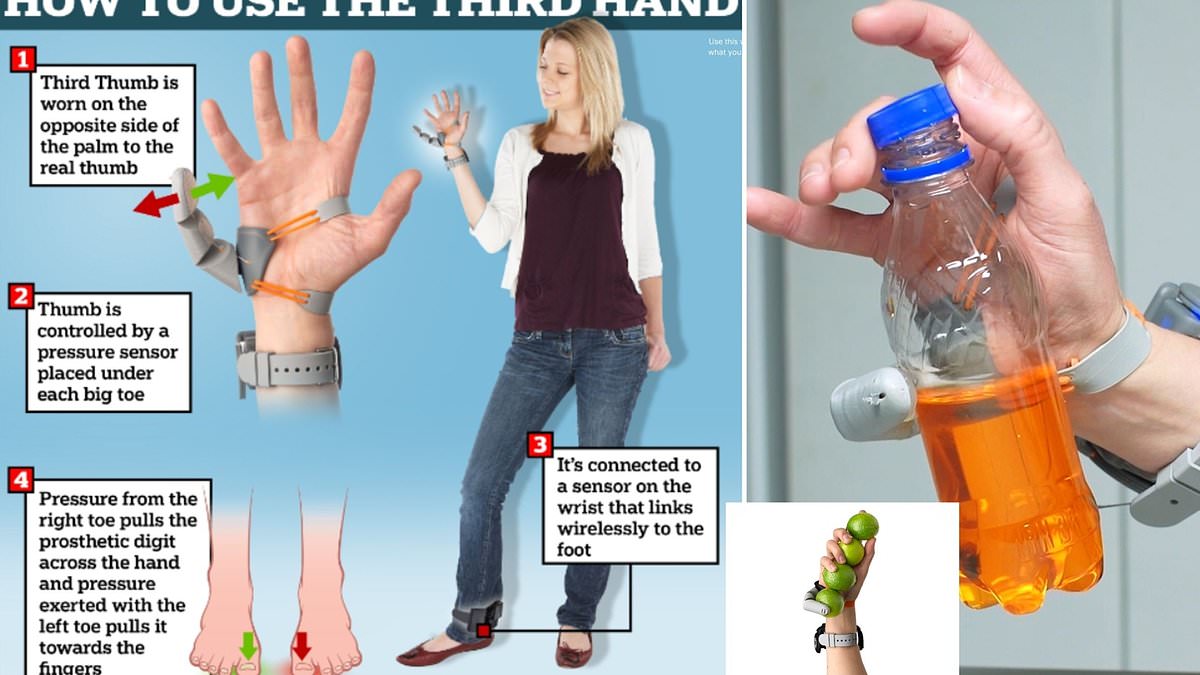By Jonathan Chadwick For Mailonline
10:24 30 May 2024, updated 10:38 30 May 2024
Human hands have had 10 digits for millions of years.
But it seems that scientists IN The University of Cambridge does not think this is quite enough.
Experts have created the ‘Third Finger’ – a controllable prosthesis that attaches to the edge of the right hand.
It allows users to pick up objects, open drink bottles, shuffle playing cards, peel a banana and even thread a needle – all with just one hand.
In their study, human volunteers quickly got used to the extra digit – which could “advance our motor skills beyond current biological limitations”.

The study was led by researchers at the University of Cambridge’s MRC Cognition and Brain Science Unit and was published in Science Robotics.
Although they don’t see a future where humans naturally ‘grow big thumbs’ due to evolution, their robotic version could make people’s lives easier.
It can be especially valuable for amputees who have lost, for example, an arm and have difficulty performing daily tasks with just one hand.
“Our everyday lives are already consumed by wearable technologies and we are now seeing an increasing number of specific augmentation technologies,” study author Lucy Dowdall told MailOnline.
“The third finger can be used to extend the function of the hand – so any task that requires holding many objects at the same time, or stabilizing one item while performing one task with another.”
Designer Dani Clode, a research technician at UCL’s Plasticity Laboratory, began developing Third Thumb as part of a graduate project at the Royal College of Art.
The Third Finger is worn on the opposite side of the palm to a person’s actual thumb and is controlled by a pressure sensor located under each thumb.
Both toe sensors, which are wirelessly connected to the big toe, control various movements by instantly responding to subtle changes in pressure from the toes.
Pressure from the right finger pulls the prosthetic digit across the hand, while pressure from the left finger pulls it toward the fingers, and the released pressure returns it to its original position.
Click here to resize this module
In their study, the team tested 596 participants, aged between three and 96, who were given up to one minute to familiarize themselves with the device.
The thumb was given in different sizes so that they could fit the hands of children and adults.
Participants performed two tasks – first, they grabbed pins and placed them in a basket, and second, they manipulated and moved five or six different foam objects of different sizes.
Overall, the thumb was worn and checked successfully by 99.3 percent of the sample, the researchers found.
And 98 percent of participants were able to successfully manipulate objects using their third finger within the first minute of use.
Older and younger adults had a similar level of skill when using the device, although further investigation only within the age group of older adults revealed a decline in performance with increasing age.
“This effect may be due to the general degradation in sensorimotor and cognitive abilities associated with aging,” the team says.
“Furthermore, these effects may also reflect a generational relationship with technology.”
The thumb is not “commercially available,” and it’s unclear when or how academics might make their device available to the public, or how much it would cost.
But they hope it “could pave the way for setting a standard” for other “immersive” human-centric devices.
“Future growth technologies may have a broad impact on society and benefit many people,” they write.
